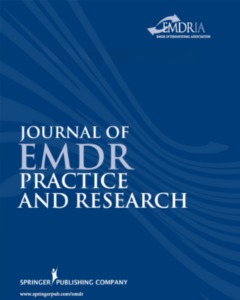Book Reviews Vol. 5, No. 3 (Journal of EMDR Practice and Research)
Reviews of recently published EMDR-related titles by Maureen Kitchur, Philip Manfield, Liz Royle and Catherine Kerr, and T. Cooper Smith.
Read MoreThe Recent-Traumatic Episode Protocol: Outcome Evaluation and Analysis of Three Case Studies (Journal of EMDR Practice and Research)
EMDR recent-traumatic episode protocol (R-TEP) protocol for a child with chronic illness, a woman with loss & adolescent who self-harmed.
Read MoreEye Movement Desensitization and Reprocessing in Counseling a Male Couple (Journal of EMDR Practice and Research)
EMDR with a male-male couple with communication problems linked to traumatic childhood memories related to sexual identity development.
Read MoreEMDR, Addictions, and the Stages of Change: A Road Map for Intervention (Journal of EMDR Practice and Research)
Use of EMDR interventions with clients presenting various levels of awareness of their addiction & varied levels of motivation to change.
Read MoreThe EMDR Protocol for Recent Critical Incidents: Application in a Disaster Mental Health Continuum of Care Context (Journal of EMDR Practice and Research)
RCT group field study after a 7.2 earthquake in Mexico. Individuals were provided EMDR Protocol for Recent Critical Incidents (EMDR-PRECI).
Read MoreEMDR versus stabilisatie bij getraumatiseerde asielzoekers en vluchtelingen: resultaten van een voorstudie (European Journal of Psychotraumatology)
Pilotstudie waarin EMDR en stabilisatie worden vergeleken met getraumatiseerde vluchtelingen en asielzoekers, met 20 deelnemers.
Read MoreEMDR versus stabilisation in traumatized asylum seekers and refugees: Results of a pilot study (European Journal of Psychotraumatology)
Pilot study comparing EMDR and stabilisation with traumatized refugees and asylum seekers, with 20 participants.
Read MoreComparison of eye movement desensitization and reprocessing with citalopram in treatment of obsessive-compulsive disorder (International Journal of Psychiatry in Clinical Practice)
Study to investigate the efficacy of EMDR compared with medication by citalopram in treatment of obsessive-compulsive disorders (OCD).
Read MoreEMDR and the adaptive information processing model: Integrative treatment and case conceptualization (Clinical Social Work Journal)
The adaptive information processing model that governs EMDR addresses the overall clinical picture with clients’ past disturbing experiences.
Read MoreA controlled comparison of the effectiveness and efficiency of two psychological therapies for posttraumatic stress disorder: Eye movement desensitization and reprocessing vs. emotional freedom techniques (The Journal of Nervous and Mental Disease)
First ever controlled comparison between EMDR and emotional freedom techniques (EFT) for posttraumatic stress disorder.
Read More


